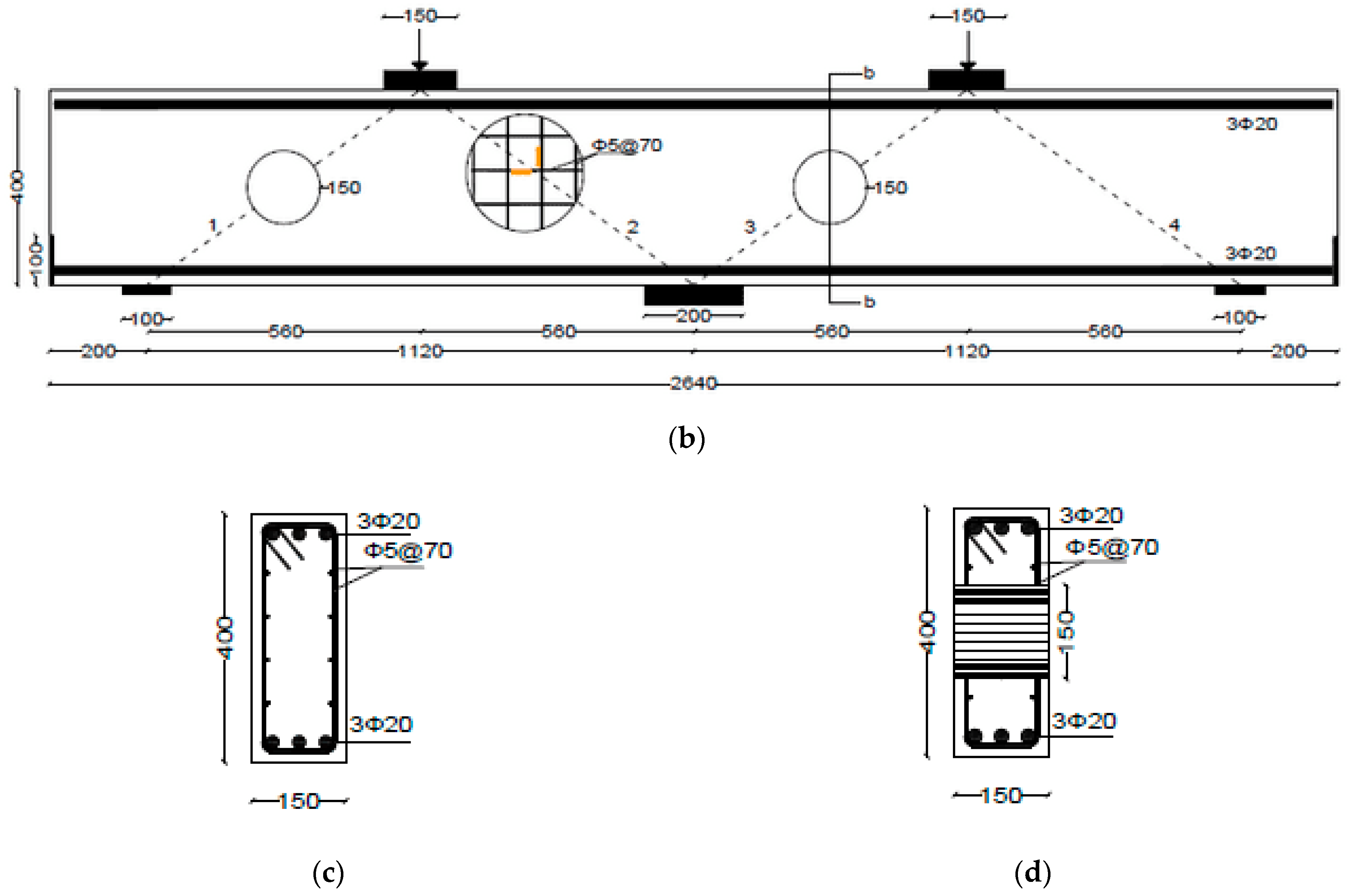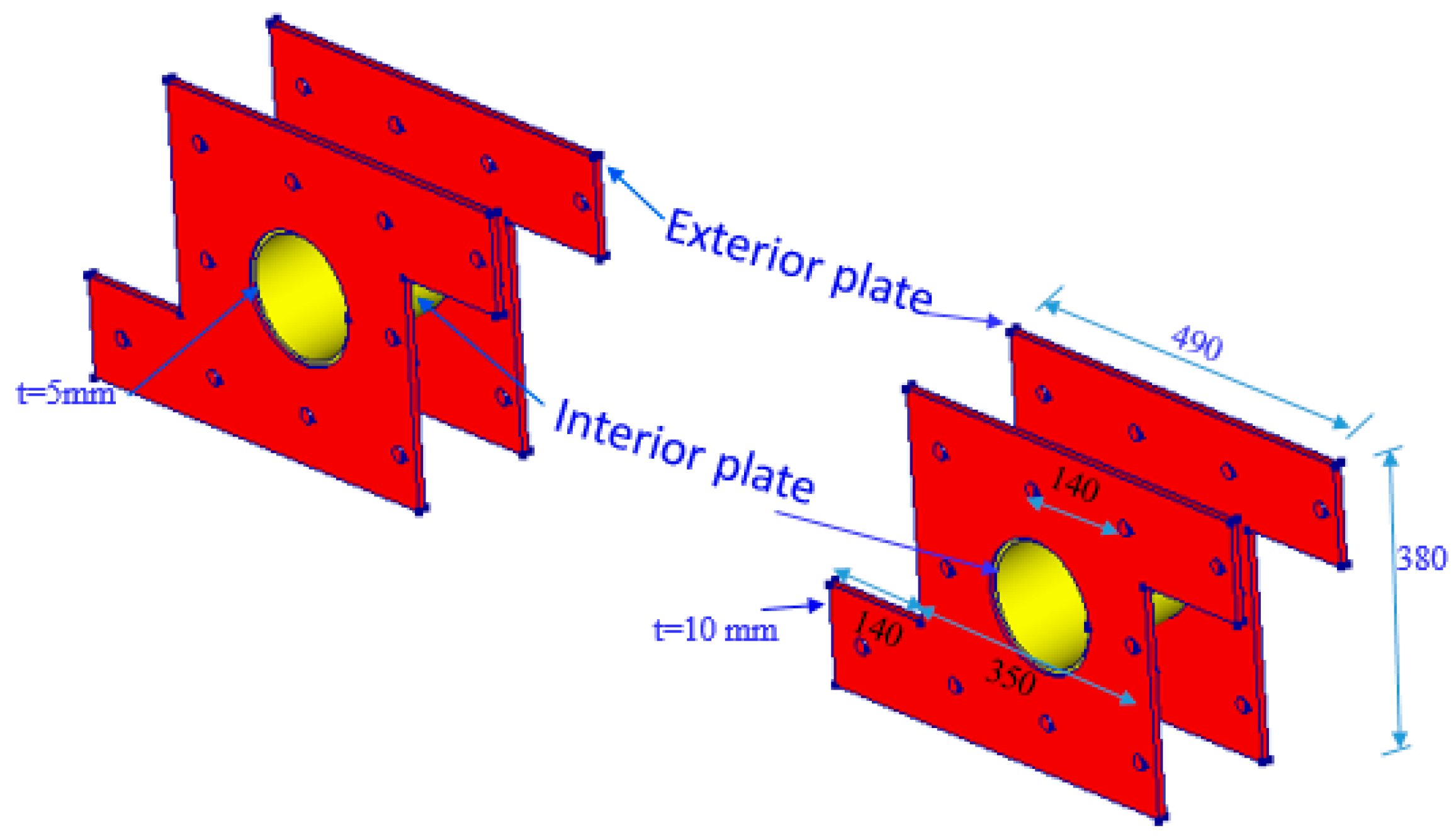Performance of HSC Continuous Deep Beams with Asymmetric Circular Openings: Hybrid FRP Versus Steel Plate Strengthening
Abstract
1. Introduction
2. Testing Campaign
2.1. Specimen Details
2.2. Characteristics of Materials
2.3. Strengthening Schemes
2.4. Instrumentation and Experimental Setup
3. Analysis and Discussion of Results
3.1. Failure Types and Cracks’ Development
3.2. Load-Deflection Response
3.3. Steel Reinforcement Stresses
3.4. Ductility
4. Conclusions
- In experiments, both the strengthening schemes of using steel plates or FRP composite demonstrated their effectiveness in restoring the strength of deep beams having openings.
- For the beam having circular openings strengthened using steel plates (COC13S1), the load capacity reached 125% compared to the reference solid beam, resulting in a remarkable 110% increase in beam strength compared to the unstrengthened specimen COC13. Similarly, for the beam strengthened using a hybrid FRP/steel plates system (COC13S2), the load capacity reached 117% compared to the reference solid beam, resulting in a load enhancement by 98% compared to the beam with circular openings COC13.
- The energy dissipation in beams retrofitted with FRP composite materials is greater than the beams retrofitted with steel plates. On average, the energy dissipation and ductility index in COC13S1 were 32% and 77% of COC13S2, respectively. These findings suggest that the use of FRP composite materials for strengthening leads to increased energy dissipation, indicating improved structural performance of this scheme of retrofitting.
- Strengthened specimens with steel plates displayed lower deflections due to their higher stiffness compared to specimens strengthened with FRP composite materials. The average mid-span deflection of the beams strengthened using steel plates was almost 52% of the deflection of the beams strengthened using FRP composites. A comparison with the control beam (no openings) shows that the average mid-span deflection of beams strengthened using steel plates is 67% of the control, whereas for the beams strengthened using FRP, it is 31% more than the control. This suggests that the FRP composite material had a more flexible behavior compared to the steel plates.
Author Contributions
Funding
Institutional Review Board Statement
Data Availability Statement
Acknowledgments
Conflicts of Interest
References
- ACI Committee. Building Code Requirements for Structural Concrete (ACI 318-25) and Commentary; American Concrete Institute: Farmington Hills, MI, USA, 2025. [Google Scholar]
- Campione, G.; Minafò, G. Behaviour of concrete deep beams with openings and low shear span-to-depth ratio. Eng. Struct. 2012, 41, 294–306. [Google Scholar] [CrossRef]
- Jasim, W.A.; Tahnat, Y.B.A.; Halahla, A.M. Behavior of reinforced concrete deep beam with web openings strengthened with (CFRP) sheet. Structures 2020, 26, 785–800. [Google Scholar] [CrossRef]
- Abadel, A.A.; Abbas, H.; Alshaikh, I.M.H.; Tuladhar, R.; Altheeb, A.; Alamri, M. Experimental study on the effects of external strengthening and elevated temperature on the shear behavior of ultra-high-performance fiber-reinforced concrete deep beams. Structures 2023, 49, 943–957. [Google Scholar] [CrossRef]
- Abbas, H.; Almusallam, T.; Abadel, A.; Alenzi, S.; Al-Salloum, Y. Shear Strength of Functionally Graded Self-Compacting Concrete Deep Beams Reinforced with Steel and GFRP Bars. Case Stud. Constr. Mater. 2023, 18, e01872. [Google Scholar] [CrossRef]
- Albidah, A.; Abadel, A.; Abbas, H.; Almusallam, T.; Al-Salloum, Y. Experimental and analytical study of strengthening schemes for shear deficient RC deep beams. Constr. Build. Mater. 2019, 216, 673–686. [Google Scholar] [CrossRef]
- Yousef, A.M.; Tahwia, A.M.; Al-Enezi, M.S. Experimental and Numerical Study of UHPFRC Continuous Deep Beams with Openings. Buildings 2023, 13, 1723. [Google Scholar] [CrossRef]
- Ashour, A.F.; Rishi, G. Tests of reinforced concrete continuous deep beams with web openings. Struct. J. 2000, 97, 418–426. [Google Scholar]
- Yang, K.H.; Chung, H.S.; Ashour, A.F. Influence of section depth on the structural behaviour of reinforced concrete continuous deep beams. Mag. Concr. Res. 2007, 59, 575–586. [Google Scholar] [CrossRef]
- Hamoda, A.; Shahin, R.I.; Abadel, A.A.; Sennah, K.; Ahmed, M.; Yehia, S.A. Shear strengthening of normal concrete deep beams with openings using strain-hardening cementitious composites with glass fiber mesh. Structures 2025, 71, 107994. [Google Scholar] [CrossRef]
- Arabzadeh, A.; Karimizadeh, H. Experimental study of RC deep beams with opening and FRP composites installed by means of EBR and EBROG methods. Constr. Build. Mater. 2019, 208, 780–791. [Google Scholar] [CrossRef]
- Fatehi Makki, R.; Talib Jassem, A.; Abd Al-Latef Jassem, H. Behavior of reactive-powder concrete deep beams with CFRP-strengthened openings. Pract. Period. Struct. Des. Constr. 2019, 24, 04019016. [Google Scholar] [CrossRef]
- Rahim, N.I.; Mohammed, B.S.; Al-Fakih, A.; Wahab, M.M.A.; Liew, M.S.; Anwar, A.; Amran, Y.M. Strengthening the structural behavior of web openings in RC deep beam using CFRP. Materials 2020, 13, 2804. [Google Scholar] [CrossRef] [PubMed]
- Allawi, A.A.; Oukaili, N.K.; Jasim, W.A. Strength compensation of deep beams with large web openings using carbon fiber–reinforced polymer sheets. Adv. Struct. Eng. 2021, 24, 165–182. [Google Scholar] [CrossRef]
- Kumari, A.; Nayak, A.N. An experimental approach for strengthening of RC deep beams with web openings using GFRP fabrics and gas actuated fasteners. J. Build. Eng. 2021, 35, 102027. [Google Scholar] [CrossRef]
- El-Mandouh, M.A.; Hu, J.W.; Abd El-Maula, A.S. Behavior of Waste Glass Powder in Concrete Deep Beams with Web Openings. Buildings 2022, 12, 1334. [Google Scholar] [CrossRef]
- Farouk, M.A.; Moubarak, A.M.; Ibrahim, A.; Elwardany, H. New alternative techniques for strengthening deep beams with circular and rectangular openings. Case Stud. Constr. Mater. 2023, 19, e02288. [Google Scholar] [CrossRef]
- Khalaf, M.R.; Al-Ahmed, A.H.A.; Allawi, A.A.; El-Zohairy, A. Strengthening of continuous reinforced concrete deep beams with large openings using CFRP strips. Materials 2021, 14, 3119. [Google Scholar] [CrossRef] [PubMed]
- Al-Mahbashi, M.; Elsanadedy, H.; Abbas, H.; Abadel, A.; Al-Salloum, Y. Experimental and numerical study of high strength reinforced concrete continuous deep beams with circular and rectangular openings. J. Build. Eng. 2023, 79, 107868. [Google Scholar] [CrossRef]
- Abbas, H.; Al-Mahbashi, M.; Elsanadedy, H.; Abadel, A.; Almusallam, T.; Al-Salloum, Y. Strengthening of high-strength RC continuous deep beams having rectangular web openings using bolted steel plates. Eng. Struct. 2025, 337, 120519. [Google Scholar] [CrossRef]
- ASTM C39/C39M-21; Standard Test Method for Compressive Strength of Cylindrical Concrete Specimens. ASTM International: West Conshohocken, PA, USA, 2017.
- ASTME8/E8M-16a; Standard Test Methods for Tension Testing of Metallic Materials. ASTM International: West Conshohocken, PA, USA, 2016.
- ANSI/AISC 360-16; Specification for Structural Steel Buildings. American Institute of Steel Construction (AISC): Chicago, IL, USA, 2016.
- ASTM A36/A36M-19; Standard Specification for Carbon Structural Steel. ASTM International: West Conshohocken, PA, USA, 2019.
- NZS 4203:1992; Code of Practice for General Structural Design and Design Loadings for Buildings. Standards Association of New Zealand: Wellington, New Zealand, 1992.
- Rao, G.A.; Kunal, K.; Eligehausen, R. Shear strength of RC deep beams. In Proceedings of the 6th International Conference on Fracture Mechanics of Concrete and Concrete Structures, Catania, Italy, 17–22 June 2007; Volume 2, pp. 693–699. [Google Scholar]

















| Beam ID | Beam Layout |
|---|---|
| CS |  |
| COC13 |  |
| COC13S1 |  |
| COC13S2 |  |
| Beam ID | Total Peak Load (kN) | Vertical Mid-Span Deflection of Left Span (mm) | Vertical Mid-Span Deflection of Right Span (mm) | Energy Dissipated Up to the Ultimate Stage (kN.mm) | ||
|---|---|---|---|---|---|---|
| At Peak Load | At Ultimate Stage | At Peak Load | At Ultimate Stage | |||
| CS | 1078 | 5.2 | 7.0 | 8.3 | 12.8 | 8027 |
| COC13 | 639 | 3.0 | 9.1 | 4.1 | 9.9 | - |
| COC13S1 | 1344 | 4.5 | 7.0 | 4.6 | 6.4 | 5887 |
| COC13S2 | 1263 | 8.3 | 17.0 | 9.1 | 18.7 | 18,566 |
| Beam ID | Peak Stress (MPa) in | |||
|---|---|---|---|---|
| Bottom Rebars | Top Rebars | Horizontal Stirrups | Vertical Stirrups * | |
| CS | 466 | NA | 358 | 527 |
| COC13 | 254 | 93 | 496 | 430 |
| COC13S1 | 441 | 216 | NA | 527 |
| COC13S2 | 560 | 301 | 411 | 527 |
Disclaimer/Publisher’s Note: The statements, opinions and data contained in all publications are solely those of the individual author(s) and contributor(s) and not of MDPI and/or the editor(s). MDPI and/or the editor(s) disclaim responsibility for any injury to people or property resulting from any ideas, methods, instructions or products referred to in the content. |
© 2025 by the authors. Licensee MDPI, Basel, Switzerland. This article is an open access article distributed under the terms and conditions of the Creative Commons Attribution (CC BY) license (https://creativecommons.org/licenses/by/4.0/).
Share and Cite
Al-Mahbashi, M.; Elsanadedy, H.; Abadel, A.; Abbas, H.; Almusallam, T.; Al-Salloum, Y. Performance of HSC Continuous Deep Beams with Asymmetric Circular Openings: Hybrid FRP Versus Steel Plate Strengthening. Polymers 2025, 17, 3049. https://doi.org/10.3390/polym17223049
Al-Mahbashi M, Elsanadedy H, Abadel A, Abbas H, Almusallam T, Al-Salloum Y. Performance of HSC Continuous Deep Beams with Asymmetric Circular Openings: Hybrid FRP Versus Steel Plate Strengthening. Polymers. 2025; 17(22):3049. https://doi.org/10.3390/polym17223049
Chicago/Turabian StyleAl-Mahbashi, Mohammed, Hussein Elsanadedy, Aref Abadel, Husain Abbas, Tarek Almusallam, and Yousef Al-Salloum. 2025. "Performance of HSC Continuous Deep Beams with Asymmetric Circular Openings: Hybrid FRP Versus Steel Plate Strengthening" Polymers 17, no. 22: 3049. https://doi.org/10.3390/polym17223049
APA StyleAl-Mahbashi, M., Elsanadedy, H., Abadel, A., Abbas, H., Almusallam, T., & Al-Salloum, Y. (2025). Performance of HSC Continuous Deep Beams with Asymmetric Circular Openings: Hybrid FRP Versus Steel Plate Strengthening. Polymers, 17(22), 3049. https://doi.org/10.3390/polym17223049






